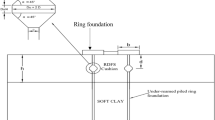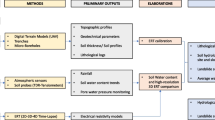Abstract
In the present study, the large-scale excavation in the construction is numerically back-analyzed using a soil–water-coupled finite element method with an elasto-viscoplastic model which considers the strain-induced degradation. The measurements of the deformation have been performed during the construction of a new railway station in Osaka, Japan, in which a large and deep excavation has been successfully carried out using a special deep mixing type of soil improvement method with earth retaining walls through the thick Holocene Osaka Umeda clay deposit. A comparison between the numerical results and the measurements of the excavation at Osaka shows that the simulation method can reproduce the overall deformation of the soft ground and the earth retaining walls including the time-dependent behaviour during the excavation and a deep mixing soil improvement method as an additional technique for stability are effective.

















Similar content being viewed by others
References
AIJ (Architectural Institute of Japan) (2006) Symposium on various problems of design of the earth retaining wall. Committee report (Estimation of the effect of neighboring construction and countermeasure) (in Japanese)
Boonlert S, Oka F, Kimoto S, Kodaka T, Higo Y (2007) Elasto-viscoplastic finite element study of the effect of degradation on bearing capacity of footing on clay ground. Geomech Geoeng 2(4):235–251
Brown PT, Booker JR (1985) Finite element analysis of excavation. Comput Geotech 1:207–220
Building Center of Japan (2002) Revised version of the guide line for the design of soil improvement of building and its quality control, deep and shallow mixing method using cement type solidification material. Showa Jyoho Process (in Japanese)
Finno RJ, Blackburn JT (2007) Three-dimensional effects for supported excavations in clay. J Geotech Geoenviron Eng 133(1):1, 30–36
Higo Y, Oka F, Nagaya J, Watanabe T (2006a) Relationship between strain rate sensitivity and secondary compression coefficient. In: Proceedings of the 61st annual meeting of JSCE, vol 262, pp 519–520 (in Japanese)
Higo Y, Oka F, Kodaka T, Kimoto S (2006) Three-dimensional strain localization of water-saturated clay and numerical simulation using an elasto-viscoplastic model. Philos Mag 86(21–22):3205–3240
Japan Architecture Center (2002) Revised version: design of improved ground for building and guideline for quality control-deep and shallow mixing method using cement solidification material. Shyowa Jyoho Process Co
Karim MR, Oka F, Krabbenhoft K, Leroueil S, Kimoto S (2013) Simulation of long-term consolidation behavior of soft sensitive clay using an elasto-viscoplastic constitutive model. Int J Numer Anal Methods 37:2801–2824
Kimoto S, Oka F (2005) An elasto-viscoplastic model for clay considering destructuralization and consolidation analysis of unstable behavior. Soils Found 45(2):29–42
Leroueil S, Samson L, Bozozuk M (1983) Laboratory and field determination of preconsolidation pressures at Gloucester. Can Geotech J 20(3):477–490
Mukai H (2009) Deformation analysis of earth-retaining wall and ground induced by the open cut construction. Ph D. Thesis, Kyoto University (in Japanese)
Oka F, Higo Y, Kimoto S (2002) Effect of dilatancy on the strain localization of water-saturated elasto-viscoplastic soil. Int J Solids Struct 39(13–14):3625–3647
Oka F, Higo Y, Nakano M, Mukai H, Izunami T, Kakeda S, Amano K, Nagaya J (2009) Deformation analysis of earth-retaining wall during excavation of Nakanoshima soft clay deposit by an elasto-viscoplastic finite element method. JSCE J Geotech Geoenviron Eng C 65(2):492–505 (in Japanese)
Oka F, Kimoto S (2012) Computational modeling of multiphase geomaterials. CRC press, Taylor & Francis Group, Boca Raton, FL, USA
Railway Technical Research Institute of Japan (2001) Standard for design of railway structures and interpretation, open-cut tunnel. Maruzen Co., 59–64 and Referential material No. 11, Real rebound and its calculation examples. Maruzenn Co., 429–436 (in Japanese)
Railway Technical Research Institute of Japan (2004) Standard for design of railway structures and interpretation, concrete structures. Maruzen Co., 79 (in Japanese)
Takada N (2012) Elasto-viscoplastic analysis of large scaleexcavation of soft clay depositconsidering soil improvement. Ph. D. Thesis, Kyoto University (in Japanese)
Tanaka H (1994) Behavior of a braced excavation in soft clay and the undrained shear strength for passive earth pressure. Soils Found 34(1):53–64
Uto K (1967) Sounding of ground, foundations of structures. Kansai Branch of Japan Society of Testing Materials, pp 33–66 (in Japanese)
West Japan Railway Company, JR West Japan Consulting Company and Joint venture group for the construction and improvement of Osaka Station (2011) Report of Technical Committee of Construction and Improvement for Osaka Station, May 2011 (in Japanese)
Whittle AJ, Davies RV (2006) Nicoll highway collapse: evaluation of geotechnical factors affecting design of excavation support system. In: Proceedings of international conference on deep excavations, 28–30 June 2006, Singapore, pp 1–16
Acknowledgments
The authors would like to express their sincere thanks to the JR West Japan Railway Company for their support, comments, and suggestions.
Author information
Authors and Affiliations
Corresponding author
Appendices
Appendix 1: Elasto-viscoplastic constitutive model for clay considering structural changes
For the constitutive model for clay, an elasto-viscoplastic model which considers structural changes is used. The model is an over-stress type of viscoplasticity theory considering the material instability brought about by microstructural changes in the geomaterials [10].
The deviatoric and volumetric viscoplastic strain rates are given by
where \(\dot{e}_{ij}^{vp}\) is the deviatoric viscoplastic strain rate tensor, \(\dot{\varepsilon }_{\text{kk}}^{vp}\) is the viscoplastic volumetric strain rate, \(\sigma_{m}^{\prime }\) is the mean effective stress, C 01, C 02, and m′ are viscoplastic parameters, \(\bar{\eta }^{*}\) is the relative stress ratio, \(\eta_{ij}^{*}\) is the stress ratio tensor, subscript (0) indicates the initial state, Sij is the deviatoric stress tensor, \(\tilde{M}^{*}\) is the dilatancy coefficient, fp is the plastic potential function, \(\sigma_{ij}^{\prime }\) is the effective stress tensor, and \(\sigma_{\text{mb}}^{\prime }\) is a hardening–softening parameter given as follows:
where \(\sigma_{\text{maf}}^{\prime }\) and \(\sigma_{\text{mai}}^{\prime }\) are the final and the initial values of structural parameter \(\sigma_{\text{ma}}^{\prime }\), respectively, β is a parameter denoting the rate of degradation of the structure, e is the void ratio, λ is the compression index, κ is the swelling index, and. z is an accumulation of the second invariant of viscoplastic strain rate \(\dot{\varepsilon }_{ij}^{vp}\).
From the above equations, it is seen that the decrease in \(\sigma_{\text{mb}}^{\prime }\) in Eq. (8) can lead to softening behaviour and that Eq. (6) can describe the positive dilatancy depending on the stress ratio.
In the above formulation, no pure elastic region is taken into consideration although the over-stress type elasto-viscoplasticity can, in general, include the elastic region. However, in the present analysis, the viscoplastic parameters C 01 and C 02 are small as 10−11/s. Hence the effect of the elastic region is negligible even for the unloading process.
Appendix 2: Soil–water-coupled finite element method
For the numerical simulation, we use a finite element method for two-phase mixtures based on the finite deformation theory. In general the strain level in the analysis is not high in the whole domain but locally the strain may be not so small since the ground deformation may includes strain localization. In addition, the strain level induced in the construction activity cannot be known before analysis, and the finite deformation analysis is sufficient in general, but the small strain analysis is not. Based on the above consideration, we have used a finite deformation theory in the present analysis.
Biot’s type of two-phase mixture theory is adopted to give the governing equations of the soil–water coupling problem (e.g., [13, 15]. An updated Lagrangian method with the objective Jaumann rate of Cauchy stress is used for the weak form of the rate type of equilibrium equations for the soil–water whole mixture which is given by the following equation:
in which \(\delta \varvec{v}\) is the virtual velocity vector, \(\dot{\varvec{S}}_{\varvec{t}}\) is the nominal stress rate tensor, T denotes the Cauchy stress tensor, L denotes the velocity gradient tensor, and the superimposed dots indicate the time differentiation.
For the fluid phase, the weak form of the continuity equation is employed. The types of elements used in the three-dimensional analysis are eight-node isoparametric elements with a reduced Gaussian (2 × 2) integration for the soil skeleton and four-node isoparametric elements with a full (2 × 2) integration for the pore fluid. Detailed formulations of the equilibrium equation and the continuity equation can be found in the references, e.g., Oka et al. [13] and Higo et al. [6, 7].
Appendix 3
The results of the parametric study are illustrated in the Figs. 18, 19, 20, 21, 22 and 23. The results show that the present value for E is reasonable considering the displacement of the retaining wall and the deformation of soil. Hence, considering the recommendation by RTRI (16) and the parametric study on E, we have adopted a Young’s modulus which is 1.5 times larger for the Dg1 layer and one which is 2.0 times larger for the Dg2 layer, which is consistent with the fact that the Pleistocene gravel layers are stiff and the expected strains are small.
Rights and permissions
About this article
Cite this article
Oka, F., Takada, N., Shimono, K. et al. A large-scale excavation in soft Holocene deposit and its elasto-viscoplastic analysis. Acta Geotech. 11, 625–642 (2016). https://doi.org/10.1007/s11440-016-0445-9
Received:
Accepted:
Published:
Issue Date:
DOI: https://doi.org/10.1007/s11440-016-0445-9










